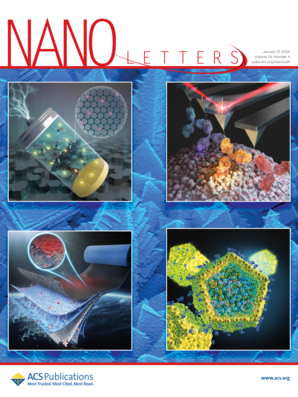Plasmon-Driven Synthesis of Cu Nanostructures
IF 9.6
1区 材料科学
Q1 CHEMISTRY, MULTIDISCIPLINARY
引用次数: 0
Abstract
Plasmonic photochemistry holds great promise for optical control of materials growth at the nanoscale. To date, however, this unique approach to the synthesis of monometallic metal nanostructures remains restricted to just two elements: silver (Ag) and gold (Au). Here, we report the plasmon-driven synthesis of copper (Cu) nanostructures in aqueous solution via seed-mediated growth. The entire synthesis was conducted under an inert atmosphere, with precise control over solution pH and reaction temperature to prevent oxide formation. We found that the growth of triangular and hexagonal Cu nanoprisms was determined by the concentration of the surfactant polyvinylpyrrolidone in the growth solution. A series of photochemical experiments and control reactions were also performed to confirm that the growth of Cu nanostructures occurs via plasmonic photocatalysis. Our approach offers a unique route to the growth of Cu nanostructures and expands the domain of plasmon-driven synthesis to a new element in the periodic table.

等离子体驱动的铜纳米结构合成
等离子体光化学在纳米尺度上对材料生长的光学控制具有很大的前景。然而,到目前为止,这种合成单金属纳米结构的独特方法仍然局限于两种元素:银(Ag)和金(Au)。在这里,我们报道了等离子体驱动下通过种子介导生长在水溶液中合成铜(Cu)纳米结构。整个合成过程在惰性气氛下进行,精确控制了溶液pH和反应温度,以防止氧化物的形成。我们发现三角形和六边形铜纳米棱镜的生长是由表面活性剂聚乙烯吡咯烷酮在生长溶液中的浓度决定的。通过一系列光化学实验和控制反应,证实了铜纳米结构的生长是通过等离子体光催化进行的。我们的方法为Cu纳米结构的生长提供了一条独特的途径,并将等离子体驱动合成的领域扩展到元素周期表中的新元素。
本文章由计算机程序翻译,如有差异,请以英文原文为准。
求助全文
约1分钟内获得全文
求助全文
来源期刊

Nano Letters
工程技术-材料科学:综合
CiteScore
16.80
自引率
2.80%
发文量
1182
审稿时长
1.4 months
期刊介绍:
Nano Letters serves as a dynamic platform for promptly disseminating original results in fundamental, applied, and emerging research across all facets of nanoscience and nanotechnology. A pivotal criterion for inclusion within Nano Letters is the convergence of at least two different areas or disciplines, ensuring a rich interdisciplinary scope. The journal is dedicated to fostering exploration in diverse areas, including:
- Experimental and theoretical findings on physical, chemical, and biological phenomena at the nanoscale
- Synthesis, characterization, and processing of organic, inorganic, polymer, and hybrid nanomaterials through physical, chemical, and biological methodologies
- Modeling and simulation of synthetic, assembly, and interaction processes
- Realization of integrated nanostructures and nano-engineered devices exhibiting advanced performance
- Applications of nanoscale materials in living and environmental systems
Nano Letters is committed to advancing and showcasing groundbreaking research that intersects various domains, fostering innovation and collaboration in the ever-evolving field of nanoscience and nanotechnology.
 求助内容:
求助内容: 应助结果提醒方式:
应助结果提醒方式:


